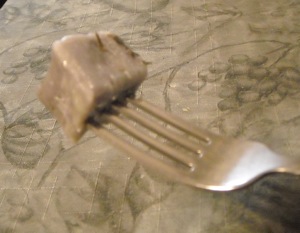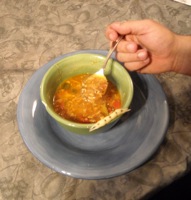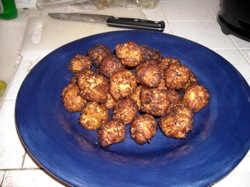A season of feasting is again upon us, and Tor.com has decided to, in the interest of promoting geeky frivolity and whatnot, collect my Science Fiction Cuisine posts. Not only will I revisit the glory of homemade Popplers and Spoo, I’ll also include, at the end, a few “leftovers,” miscellany of the edible variety.
Before we get into all that, I wanted to give a few general pointers for making food more science fictional, at least in a cosmetic sense. While my posts deal with the trills and tribble-ations of re-creating food from SF sources, I want to share what I’ve learned about how to make any dish a little weirder. With a little extra effort, you can make well-known dishes into visually arresting, delicious oddities fit for a Klingon.
- Play with shapes. When I visited Thailand years ago, I marveled at the Thai art of garnishing. Thai cooks carve and shape food into wondrous sculpture, giving a carrot the elegance of a temple entrance. Their garnishes give the dishes a distinct Thai character. The same is possible with SF food. A familiar ingredient can be altered to appear futuristic. The two easiest shapes for this effect are cubes and tendrils. My recipe for Babylon 5’s flarn, for example, is mostly a log of goat cheese made into cubes instead of the usual cylinder. Holiday cheese balls and logs could be transformed without any great effort into cheese borg-ships. A simple green salad can become exotic when you cut the ingredients into unfamiliar configurations. Regular old green beans can be split at one end several times over (before cooking) to change the ubiquitous Thanksgiving casserole into a vat of mini-Cthulhus. Also, candies such as tootsie rolls and starbursts (which, I’m told, were originally called “Opal Fruits,” a vastly more interesting name) can be kneaded, rolled, cut and shaped like modeling clay.
- Play with spices. In Lebanon, rice is sometimes flavored with cinnamon. Though rice and cinnamon, separately, are very familiar, the combination often pleasantly startles my guests when I serve this. A similar result came when a friend of mine, on a whim, added cardamom to cranberry sauce. The pairing, though unfamiliar, worked brilliantly. When concocting a banquet of future-food, branch out from your usual herb and spice combinations. If you have a Middle Eastern, Asian or Indian grocer nearby, chat with the owners and get cooking tips. Try spices you’ve never heard of before. The less familiar the flavor, the more potential it has to transform well-known dishes.
- Play with technique. A recipe for lentil soup in Cook’s Illustrated (not to be confused with Cooks Source!) paired Indian cooking techniques with French ingredients, with great success. Every region of the world has culinary specialties. Thanks to the internet and ever-increasing communication between cultures, the cooking styles of the planet are available to us. Using the ingredients familiar to one culture, cooked in the style of another, can give rise to some really cool new combinations. Japan, since the Meiji Restoration, has made great use of this, and we have tempura and Japanese curry and other dishes, as a result. And as for SF cuisine, what could be more futuristic than serving a fusion of flavors never achieved before?
- Play with color. Just ask Sam-I-Am; changing the expected color of a dish can profoundly augment the presentation. As a general rule, I dislike using food coloring. It feels like cheating, and an empty experience. Sometimes it can’t be avoided, and I think that in small amounts, it is okay, but I like to use ingredients for coloring. The reddish tint in my recipe for Qagh, f’rinstance, comes from pomegranate juice rather than red food coloring. Root vegetables and berries can yield good red, orange, yellow and purple colors. Green is easiest of all, of course. Blue is a hard one, though. Blue fruit usually gives purple juice.
- Experiment in advance. If there is one thing I have learned in making these recipes, it’s that a whole lot can go wrong. Do not, therefore, save your experimentation for the day of Thanksgiving or Christmas or whatever the special occasion may be. Do it in advance, give yourself room for failure and modification, and take notes as you go, so you’ll get it right on the day you are entertaining your favorite host of nerds.
I know that cooking intimidates a lot of people. This is why I emphasize fun, learning and experimenting in all the posts. I am a firm believer that “perfect is the enemy of good.” Not everyone will be Julia Child or Jacques Pepin. That’s fine. Not everyone will be Rodin or Van Gogh, either, but that shouldn’t stop you from having fun with Play-doh or finger painting.
 |
4/19/09 – Science Fiction Cuisine – The Spoo Elevating Moment |
 |
4/26/09 – Science Fiction Cuisine – Like Granny Used To Make |
 |
5/03/09 – Science Fiction Cuisine – Eat Up, Meatbags! |
 |
5/10/09 – Science Fiction Cuisine – Today is a Good Day to Diet |
 |
5/19/09 – Science Fiction Cuisine – I Find My Lack of Success Disturbing |
 |
7/13/09 – Science Fiction Cuisine – Share and Enjoy |
Jason Henninger cooks stuff for people who eat it. Won’t you?











This is a great idea. It’ll be a lot of fun to see how people would react if I served them Blue Milk and Food Rations, hehe. I’ll try to have a go at some of these.
What a fun post!
Using the ingredients familiar to one culture, cooked in the style of another, can give rise to some really cool new combinations. Japan, since the Meiji Restoration, has made great use of this, and we have tempura and Japanese curry and other dishes, as a result.
Possibly an even better example is Italians adopting the tomato (native to the New World and completely unknown to the Romans).
@3
The tomato is an excellent example. Or capsicum peppers in Indian and Southeast Asian foods. Hard to imagine Indian food without it, and yet, in the scope of indian history, it’s pretty new.
Ketchup has an international origin as well, originally close to soy sauce and fish sauce, later had tomatos added (or mushrooms, nuts..I once saw a recipe in an old cookbook for oyster ketchup!). And soy sauce itself, which you can now find in just about any grocery store in the US, was hardly known here outside of Asian families 40 or so years ago.
ok, I’ll stop there..I can go on and on and on about culinary history.
Alternately, there are cookbooks composed of recipes contributed by SF writers. I have two — Cooking Out of this World and Serve It Forth; I believe I’ve heard of at least one other, but don’t recall the title.
Instead of “playing” with your food (and wasting it) I suggest you learn something about how spices can enhance the flavor of certain foods. You can put chocolate in beer. That doesn’t mean it belongs there.
Hrmmm…It appears that cinemabon is missing the whimsy sauce.
My best friend swears by both chocolate wine and chocolate stout. Quite yummy according to her. I’ve also heard of many parings of wine and chocolate dipped strawberries. Chocolate and chillies are another great combo; some people swear by chipolte brownies. In the end, I think many people would be surprised at what people used to eat, and if we took our recipes back in time, they’d be startled and disgusted by what we consider gourmet food.
Ah, yes! Spoo, the other blue meat!